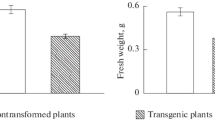Abstraet
The rate of RNA synthesis in shoot apices of the short-day (SD) plantChenopodium rubrum was compared in three successive dark periods required for flowering.32P label was used for fractionation of RNA on slabs of polyacrylamide gels on mioroscopic slides. Incorporation of32P and3H-uridine into apices was followed using histoautoradiography under identical conditions for oomparison. The lowest rate of synthesis was found on the seoond day of induction. A slight increase was usually observed in the third dark period, possibly linked with the first anatomical and/or morphological changes whioh have appeared due to mduction. Most of the label was found in ribosomal BNA in this case. After the plants wero transferred from light to darkness RNA synthesis in the shoot apex decreased within three hours. There was good agreement between results obtained by eleotrophoresis and by histoautoradiography. All previous observations which have been obtained using cytophotometry and histoautoradiography were confirmed.
The rate of synthesis of BNA in shoot apices is paralleled by that in primordial leavea. The marked rise of RNA synthesis during the inductive period, found in some planta requiring only single inductive cycle, was not established inChenopodium. A different pattern of RNA synthesis between plants flowering after one and after several dark periods, is suggested in discussion.
Similar content being viewed by others
Refercnces
Arzee, T., Zilberstein, A., Gressel, J.: Immediate intraplumular distribution of maoromolecular syntheses following floral induction inPharbitis nil. - Plant Cell Physiol.16: 505 to 511, 1975.
Bronchart, R., Bernieb, G., Kinet, J. M., Havelange, A.: RNA synthesis in the cells of the apical meristem ofSinapis alba during transition from the vegetative to the reproduotive condition. - Planta91: 255–269, 1970.
Daneholt, B., Ringborg, U., Egyhazy, E., Lambert, B.: Microelectrophoretie technique for fractionation of RNA. - Nature218: 292–293, 1968.
Gressel, J., Zilberstein, A., Arzee, T.: Bursts of inoorporation into RNA and ribonuclease activities associated with induction of morphogenesis inPharbitis. - Develop. Biol.22: 31 to 42, 1970.
King, R. W.: Mnltiple circadian rhythms regulate photoperiodic flowering responses inChenopodium rubrum. - Can. J. Bot.53: 2631–2638, 1975.
Krekule, J.: Actinomycin D effect on flowering inChenopodium rubrum L. - Z. Pflanzenphysiol.64: 65–68, 1971.
Krekule, J., Seidlová, F.: Treatments that enhance flowering in the post-inductive period of a short-day plant,Chenopodium rubrum L. - Ann. Bot.37: 615–623, 1973.
Kysela, F., Krekule, J.: [A device for32P radioaotivity evaluation when using polyacrylamide gel electrophoresis on microslides.] In Czech. - Chemické Listy71: 316–319, 1977.
Loening, U. E., Ingle, J.: Diversity of RNA oomponents in green plant tissues. - Nature215: 363–367, 1967.
Seidlová, F.: Changes of growth and RNA synthesis in shoot apical moristems ofChenopodium rubrum as a consequence of photoperiodic induotion. - Z. Pflanzenphysiol.73: 394–404, 1974.
Seidlová, F.: Growth correlations and RNA synthesis in different parts of the shoot apical meristem ofChenopodium rubrum L. induced to flowering. - Biol. Plant.18: 19–25, 1976.
Seidlová, F.: Fluotuations of uridine incorporation in the shoot apex ofChenopodium rubrum L. during photoperiodic induction. - Biol. Plant.19: 136–141, 1977.
Seidlová, F., Krekule, J.: Growth effect of 2-thiouracil and possibility of seleotive inhibition of floral differentiation inChenopodium rubrum L. - Biol. Plant.10: 41–50, 1968.
Seidlová, F., Krekule, J.: The negative response of photoperiodic floral induetion inChenopodium rubrum preoeding growth. - Ann. Bot.37: 605–614, 1973.
Stiles, J. I., Davies, P. J.: RNA metabolism in apices ofPharbitis nil during floral induotion. - Plant Cell Physiol.17: 825–833, 1976.
Teltscherová, L., Pleskotová, D.: Nucleic acid syntheais inChenopodium rubrum L. during photoperiodic induction and its relation to endogenous rhythmicity. - Biol. Plant.15: 419 to 426, 1973.
Ullmann, J., Krekule, J., Telescherová, L.: Action of inhibition by fluorodeoxyuridine and its reversal by thymidine on the overground parts of photoperiodically inducedChenopodium rubrum plants. - Biol. Plant.14: 350–355, 1972.
Author information
Authors and Affiliations
Rights and permissions
About this article
Cite this article
Krekule, J., Seidlová, F. RNA synthesis in shoot apices and young leaves ofchenopodium rubrum during three dark periods of photoperiodic floral induction. Biol Plant 19, 292–299 (1977). https://doi.org/10.1007/BF02923131
Received:
Published:
Issue Date:
DOI: https://doi.org/10.1007/BF02923131




